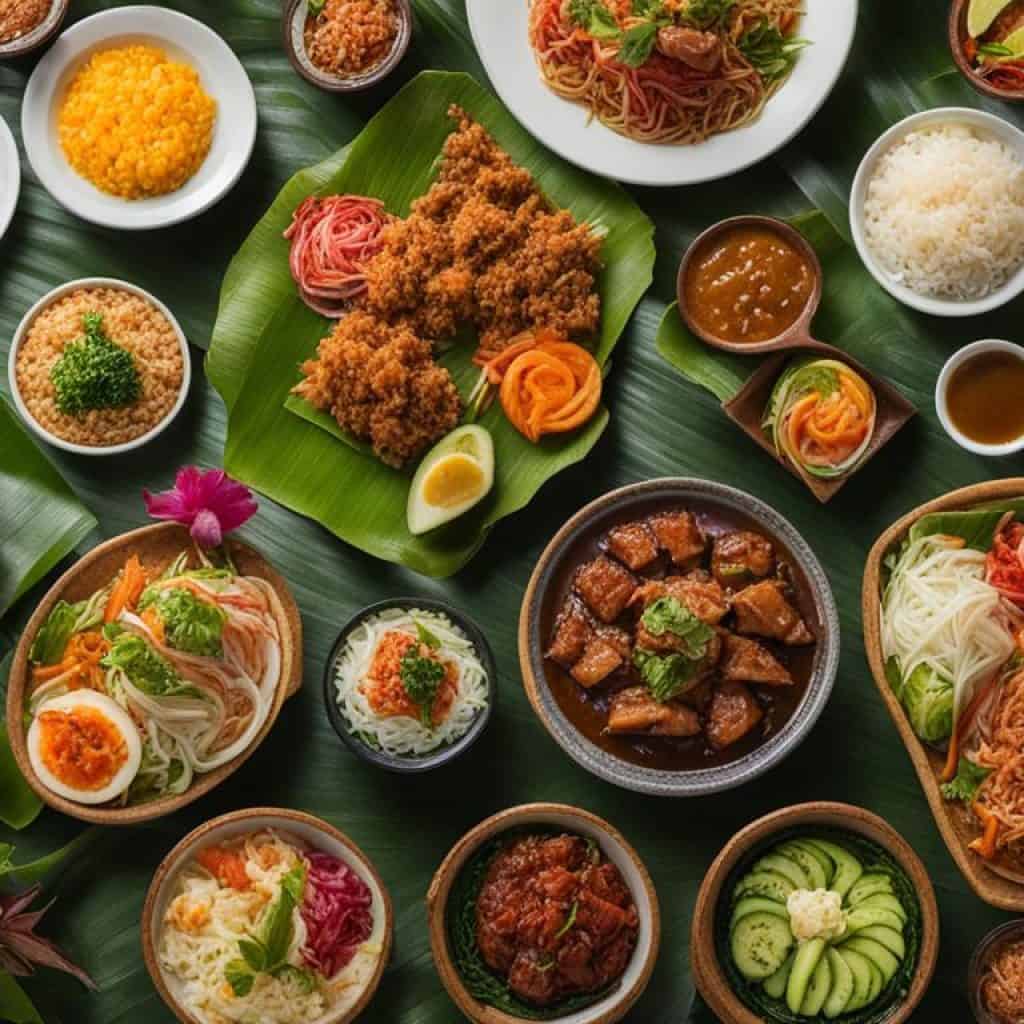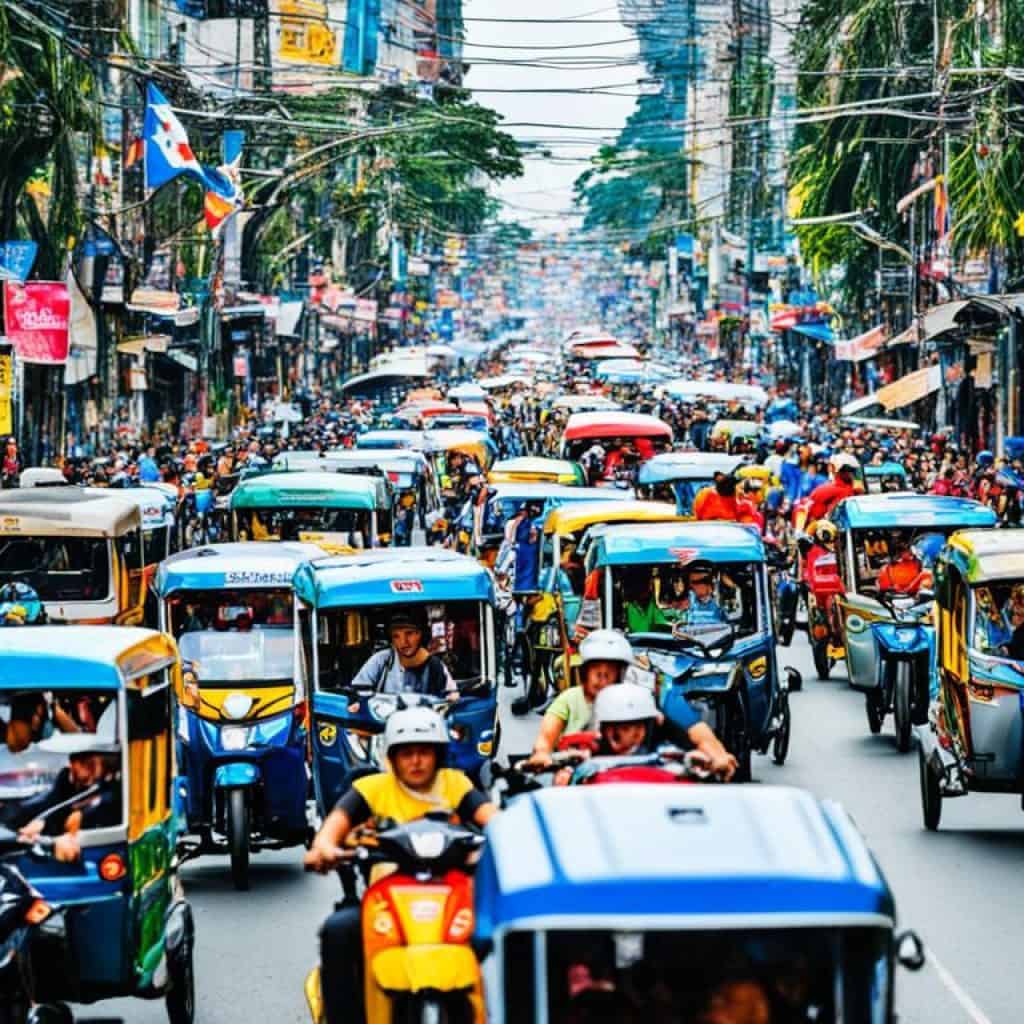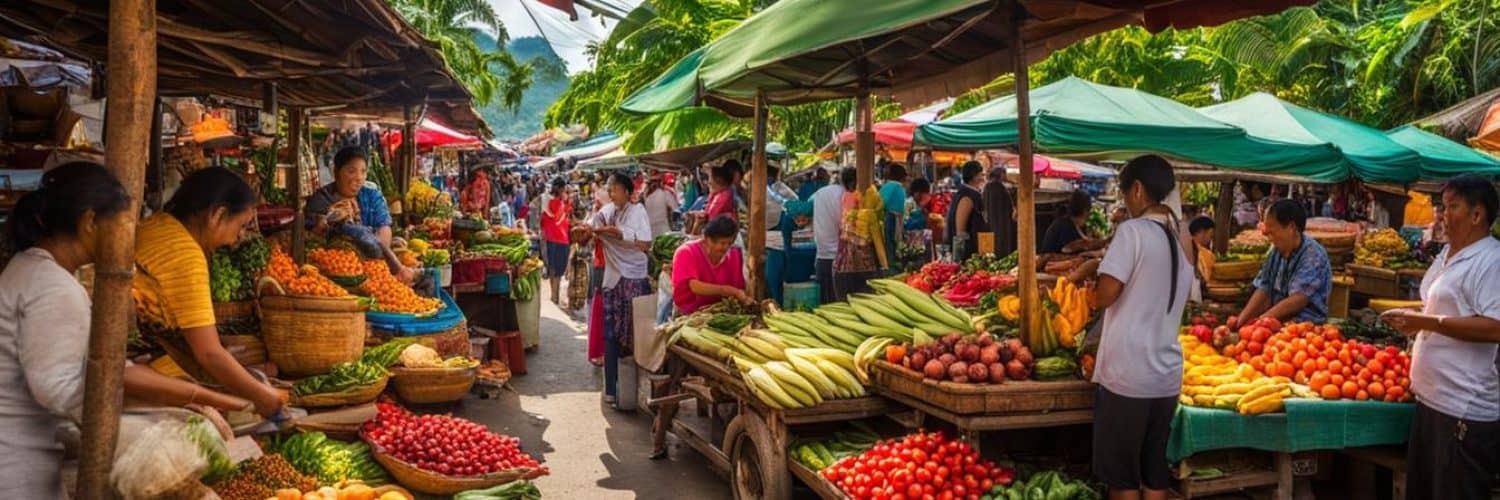Are you considering a move to the Philippines? Living in the Philippines offers a one-of-a-kind experience with its vibrant culture and warm community. But what is it really like to live there? From the affordable cost of living to the rich Filipino culture, there’s so much to discover. So, let’s dive in and uncover what awaits you in this beautiful Southeast Asian country.
Key Takeaways:
- Living in the Philippines offers an affordable lifestyle and a vibrant cultural experience.
- The cost of living in the Philippines is relatively low compared to other countries.
- The Philippines has a diverse cuisine, from traditional Filipino dishes to international flavors.
- Internet connectivity in the Philippines has improved, making it suitable for digital nomads.
- The Philippines offers a wide range of activities and adventures for expats to enjoy.
Cost of Living in the Philippines
One of the major advantages of living in the Philippines is the affordable cost of living, making it an attractive destination for retirees and expats seeking a comfortable lifestyle without breaking the bank. With the lower cost of basic necessities and services, expats can stretch their budget and enjoy a fulfilling Philippine lifestyle.
Affordable Accommodation
When it comes to accommodation, the cost of renting or purchasing a property in the Philippines is significantly lower compared to many Western countries. For instance, a one-bedroom condo in Manila can cost around £500 per month, offering expats a comfortable and convenient living space in the heart of the city.
Delicious and Affordable Food
The Philippine culinary scene is a delight for food enthusiasts, offering a wide range of delicious and affordable dining options. From street food to high-end restaurants, expats can indulge in the flavorful Filipino cuisine without worrying about blowing their budget. A nice meal at a restaurant can range from £5-8, allowing expats to savor the local delicacies without breaking the bank.
Cost-Effective Transportation and Communication
Getting around in the Philippines is not only convenient but also cost-effective. Whether it’s commuting within the cities, traveling between islands, or exploring the countryside, public transportation options such as jeepneys, tricycles, buses, and ferries offer affordable fares. For communication needs, a SIM card with 4GB data can be obtained for around £4 per month, ensuring expats stay connected without excessive expenses.
Affordable Healthcare
Retiring in the Philippines comes with the advantage of affordable healthcare. While the healthcare system may not be as advanced as in some other countries, private medical facilities are available, offering quality healthcare services at a fraction of the cost. Expats can opt for comprehensive health insurance coverage to ensure access to quality healthcare services and peace of mind.
Living in the Philippines provides a cost-effective and enriching lifestyle, allowing expats to retire comfortably, experience the vibrant Philippine culture, and make the most of their time in this beautiful archipelago.
Accommodation Options in the Philippines
When it comes to finding a place to call home in the Philippines, there are various accommodation options available, catering to different preferences and budgets. Whether you’re looking for a modern condo in bustling Manila or a cozy guest house on a picturesque island, the country has something for everyone.
If you’re planning to live in Manila, condo living is a popular choice among expats. Condos offer a more Western-style experience with amenities such as swimming pools, gyms, and 24-hour security. These condominium complexes are often located in prime areas, providing easy access to shopping malls, restaurants, and other urban conveniences.
On the islands, such as Cebu or Palawan, guest houses and small hotels are commonly preferred by travelers and long-term visitors. These accommodations offer a more intimate and laid-back experience, often surrounded by nature and breathtaking views. They provide a comfortable and affordable option, allowing expats to fully immerse themselves in the beauty of their surroundings.
Here is a comparison table of the different accommodation options in the Philippines:
| Accommodation Type | Features | Price Range | Location |
|---|---|---|---|
| Condominiums | Modern amenities, security, central location | £500-£1000 per month | Urban areas, particularly Manila |
| Guest Houses | Cozy and intimate, surrounded by nature | £20-£50 per night | Island destinations |
| Small Hotels | Comfortable accommodations, personalized service | £30-£100 per night | Various locations across the Philippines |
Ultimately, the best places to live in the Philippines will depend on your lifestyle, preferences, and budget. It’s important to explore different options, consider the location, and assess the amenities and services available before making a decision. Whether you choose a condo in the heart of the city or a tranquil guest house by the beach, the Philippines offers a range of accommodation choices to suit your needs.
Testimonial:
Food in the Philippines
Filipino cuisine is a delicious and diverse culinary experience that is sure to tantalize your taste buds. From traditional dishes like adobo and kare-kare to the bold flavors of sinigang and lechon, Filipino cuisine offers a unique blend of influences from Indigenous, Spanish, and Asian cultures.
While Filipino cuisine may not be to everyone’s taste, one of the great things about living in the Philippines is the availability of international cuisine. Expats can enjoy a wide range of culinary options, including Japanese sushi, Italian pasta, American burgers, and more.
“The Filipino cuisine holds its own unique place in the world of gastronomy, highlighting the country’s rich history and cultural diversity.” – Chef Juan Carlos de la Puente
Japanese restaurants in the Philippines offer an authentic taste of Japan with dishes like sushi, sashimi, and ramen. You can indulge in the delicate flavors of nigiri sushi, or slurp up a warm bowl of ramen topped with melt-in-your-mouth chashu pork. Whether you’re a sushi connoisseur or a ramen aficionado, you’ll find something to satisfy your cravings.
Taiwanese bubble tea shops have also gained popularity in the Philippines. These vibrant tea shops serve a variety of refreshing drinks, including the ever-popular bubble tea. Sip on a creamy milk tea with chewy tapioca pearls, or try a fruity flavored tea with jelly or boba toppings. It’s the perfect beverage to beat the tropical heat.
For those seeking convenience, delivery apps have made it easier than ever to satisfy your cravings. From pizza and burgers to Indian curry and Chinese stir-fry, you can have virtually any cuisine delivered right to your doorstep. However, it’s worth noting that delivery times may be longer due to traffic, so a little patience goes a long way.

Famous Filipino Dishes
Let’s take a closer look at some iconic Filipino dishes:
| Dish | Description |
|---|---|
| Adobo | A tangy and savory dish made with marinated meat, typically pork or chicken, cooked in vinegar, soy sauce, garlic, and spices. |
| Kare-Kare | A rich and creamy stew made with oxtail, tripe, or pork hocks, and vegetables like eggplant, bok choy, and string beans, flavored with peanut sauce. |
| Sinigang | A sour soup made with tamarind or other souring agents, mixed with meat or seafood, and a variety of vegetables. |
| Lechon | A whole roasted pig, cooked over an open fire until the skin is crispy and the meat is tender and flavorful. |
| Halo-Halo | A refreshing dessert made with crushed ice, sweetened fruits, jellies, beans, and topped with evaporated milk and leche flan. |
Whether you’re indulging in local delicacies or exploring international flavors, the vibrant food scene in the Philippines promises a culinary adventure like no other. So grab your fork, dig in, and savor the flavors of the Philippines!
Internet and Connectivity in the Philippines
In today’s digital age, reliable internet connectivity is a crucial factor for digital nomads and remote workers. Fortunately, the Philippines has made significant improvements in its internet infrastructure, making it a viable destination for those seeking a reliable connection while enjoying the beauty of this captivating country.
One of the advantages of working remotely in the Philippines is the affordable cost of living. Compared to other digital nomad hotspots, such as Bali or Chiang Mai, the Philippines offers a more budget-friendly lifestyle without compromising on the quality of amenities and experiences. This affordability, combined with the reliable WiFi infrastructure, makes the Philippines an attractive destination for digital nomads looking to stretch their income while enjoying the wonders of this beautiful archipelago.
Moreover, the Philippines is not just a place with great internet connectivity; it is also a hub for digital nomads and like-minded professionals. Networking events and co-working spaces are popping up all over the country, fostering a supportive and collaborative environment for location-independent individuals. These opportunities allow you to build connections, share ideas, and collaborate with fellow digital nomads.
“The Philippines is an emerging digital nomad hub with reliable WiFi, affordable living, and a thriving community of like-minded professionals.”
Whether you’re working on your own project or remotely for a company, the Philippines provides an ideal setting for productivity and work-life balance. After a productive workday, you can take a break and explore the lush landscapes, idyllic beaches, and vibrant culture that the Philippines has to offer.
To give you an overview of internet and connectivity in the Philippines, the table below highlights some key factors:
| Factor | Details |
|---|---|
| Internet Availability | Widespread availability of reliable WiFi in accommodations, co-working spaces, and public areas. |
| Internet Speed | Varies depending on location and service provider, with speeds ranging from 10 Mbps to 100 Mbps. |
| Cost of Internet | Average monthly cost of internet plans ranges from â±1,500 to â±3,500 (approximately $30 to $70). |
| Mobile Data | Mobile data plans are widely available, with various options for prepaid and postpaid users. |
| Co-working Spaces | An increasing number of co-working spaces offer reliable WiFi and a collaborative work environment. |
With an internet connection that meets your needs, combined with the affordability and community support found in the Philippines, you can embrace the digital nomad lifestyle while immersing yourself in the rich culture and breathtaking landscapes of this tropical paradise.
Healthcare in the Philippines
When it comes to healthcare, the Philippines may not have the most advanced system in the world. However, there are private medical facilities available to cater to the needs of expats and locals alike. The quality of care can vary depending on the location, with major cities offering more comprehensive services.
For expats planning to live in the Philippines, it is highly recommended to have comprehensive health insurance coverage. This ensures access to quality healthcare services and provides peace of mind in case of medical emergencies. One trusted insurance provider for travelers and expats in the Philippines is Heymondo.
Heymondo offers a range of insurance plans that cover medical expenses, hospitalization, and emergency medical evacuation. With their reliable coverage, expats can have the confidence to explore and enjoy the Philippines, knowing that they are protected in case of any healthcare needs.
Private vs. Public Healthcare Facilities
Private medical facilities in the Philippines generally provide better quality of care compared to public hospitals. They are equipped with modern medical equipment and often staffed by highly trained healthcare professionals. However, private healthcare services can come at a higher cost.
Public healthcare facilities, on the other hand, may have limited resources and longer waiting times. While they offer more affordable options, the quality of care may be inconsistent. It is important to carefully consider one’s specific healthcare needs and budget when choosing between public and private healthcare facilities in the Philippines.
Pharmacies and Medications
Pharmacies can be found throughout the country, making it convenient for expats to access medications and over-the-counter drugs. Many common medicines are available without a prescription. However, for certain medications or specialized treatments, a prescription from a healthcare professional may be required.
It is recommended to consult with a local healthcare provider or pharmacist to ensure the proper and safe use of medications. They can provide guidance on dosage, potential side effects, and any potential drug interactions.
Emergency Services
In case of medical emergencies, the Philippines has emergency services that can be reached by dialing 911. The response time and level of emergency medical care may vary depending on the location and the availability of ambulances and medical personnel.
Comparison of Healthcare Facilities in the Philippines
| Public Healthcare Facilities | Private Healthcare Facilities |
|---|---|
| May have limited resources | Equipped with modern medical equipment |
| Longer waiting times | Shorter waiting times |
| Affordable options | Higher cost |
| Inconsistent quality of care | Higher quality of care |
Note: The information provided in the table is a general comparison and may vary depending on specific healthcare facilities.
Having reliable access to quality healthcare is essential for a fulfilling life in the Philippines. By understanding the healthcare system, obtaining comprehensive health insurance, and making informed choices about healthcare facilities, expats can ensure their well-being and enjoy their time in this vibrant country.
Activities and Adventures in the Philippines
The Philippines is a paradise for adventure seekers, offering a plethora of exciting activities to satisfy every thrill-seeker’s appetite. With its stunning landscapes, crystal-clear waters, and diverse wildlife, the country provides an ideal playground for those seeking adrenaline-pumping experiences.
Here are some of the top things to do in the Philippines:
- Diving: Explore the mesmerizing underwater world of the Philippines, known for its vibrant coral reefs and diverse marine life. From swimming with whale sharks in Donsol to exploring the UNESCO World Heritage Site of Tubbataha Reefs Natural Park, diving enthusiasts will be in awe of the breathtaking beauty beneath the surface.
- Surfing: Ride the waves along the country’s picturesque coastline, renowned for its world-class surf spots. Siargao, dubbed the “Surfing Capital of the Philippines,” offers thrilling breaks for both beginners and experienced surfers. Whether you’re a seasoned pro or a novice, the Philippines has the perfect wave waiting for you.
- Hiking: Lace up your hiking boots and embark on an adventure through the Philippines’ lush mountains and verdant forests. Mt. Pulag, the third-highest peak in the country, offers a challenging yet rewarding trek with panoramic views of the surrounding landscapes. For a different kind of hiking experience, explore the otherworldly landscapes of the Chocolate Hills in Bohol.
- Island Hopping: With over 7,000 islands to choose from, island hopping is a must-do activity in the Philippines. Hop on a boat and explore the palm-fringed beaches, hidden lagoons, and secluded coves scattered throughout the archipelago. El Nido in Palawan and the Visayas region are particularly popular among island-hopping enthusiasts.
- Whitewater Rafting: Get your adrenaline pumping as you navigate the thrilling rapids of the Philippines’ scenic rivers. Experience the rush of whitewater rafting in Cagayan de Oro or go canyoneering in Kawasan Falls, Cebu, where you’ll jump off cliffs, slide down natural water slides, and swim in crystal-clear pools.
Immerse yourself in the beauty of the Philippines, where every corner offers exciting activities and adventures that will leave you with lasting memories.
No matter what your adventurous spirit desires, the Philippines has something to offer. From heart-stopping encounters with ocean giants to breathtaking hikes and thrilling water adventures, the country is a playground for outdoor enthusiasts.

Embark on a thrilling adventure in the Philippines and create unforgettable memories in one of the world’s most beautiful destinations.
Lessons Learned from Living in the Philippines
Living in the Philippines offers a wealth of valuable lessons for expats. Embracing the nomad life in the Philippines teaches the importance of self-care and listening to one’s body. With the warm tropical climate and diverse activities available, it becomes crucial for expats to prioritize rest and rejuvenation. Taking the time to relax and recharge allows for a deeper appreciation of the vibrant culture and natural beauty that the Philippines has to offer.
Another significant lesson from living in the Philippines is the realization that the nomad lifestyle may not be sustainable in the long run. As expats explore the country’s stunning islands and immerse themselves in its rich cultural heritage, a growing desire for a more settled life often emerges. The yearning for a place to call their own becomes stronger, as expats begin to seek a sense of permanence and stability.
These experiences in the Philippines inspire personal growth and the exploration of new possibilities. Expats who have embraced the nomad life can harness the lessons learned to create a balanced lifestyle. One such possibility is the creation of a home office that allows for location independence while still providing a sense of stability and routine. By combining the freedom of remote work with the comforts of a settled home, expats can continue to enjoy the best of both worlds.
“Living in the Philippines taught me the importance of finding a balance between exploration and stability. While the nomad life was exciting, I found myself longing for a place to call home. Creating a home office allowed me to maintain my sense of adventure while having a sanctuary to return to, ultimately enhancing my overall experience in the Philippines.” – Emily Thompson, Expat in the Philippines
Key Lessons:
Living the nomad life in the Philippines serves as a valuable teacher, imparting lessons that inspire personal growth and exploration. By finding a balance between adventure and stability, expats can make the most of their time in this beautiful country and create a fulfilling lifestyle that suits their needs and desires.
Finding the Ideal Home in the Philippines
While living in the Philippines, many expats consider purchasing property. Manila may not be the preferred choice due to its congestion and traffic. However, there are other attractive cities and regions to consider. Buying property in the Philippines is possible for foreigners, but it’s important to understand the legalities and explore different options based on personal preferences. Researching the best places to live and seeking professional advice can help expats find their ideal home in the Philippines.
Exploring the Best Places to Live in the Philippines
When looking for the best places to live in the Philippines, several factors come into play. Considerations such as proximity to the beach, access to modern amenities, and availability of healthcare facilities are important to expats. Here are a few popular cities and regions to consider:
- Metro Cebu: Known for its urban development and vibrant city life, Metro Cebu offers a mix of modern comforts and natural beauty. It boasts a thriving business district and easy access to stunning beaches, making it an attractive option for expats.
- Baguio City: Located in the mountains of Luzon, Baguio City offers a cooler climate and picturesque landscapes. This city provides a peaceful retreat from the hustle and bustle of the urban areas, making it an ideal choice for those seeking a more laid-back lifestyle.
- Palawan: Famous for its pristine beaches and crystal-clear waters, Palawan is a tropical paradise that attracts tourists and expats alike. It offers a tranquil environment with opportunities for water activities and exploration of stunning natural wonders.
These are just a few examples, and each region in the Philippines has its own unique charm. It’s important to conduct thorough research and visit different areas to determine which location suits your preferences and lifestyle.
“The Philippines offers a diverse range of locations perfect for expats looking to find their ideal home. From bustling cities to tranquil beachside towns, there’s something to suit everyone’s taste and desired lifestyle.” – Real Estate Expert
Legalities and Options for Buying Property in the Philippines
As a foreigner, it is possible to purchase property in the Philippines. However, there are legalities and restrictions to be aware of. Here are a few key points:
- Land ownership: Foreigners are generally prohibited from owning land in the Philippines. However, they can acquire condominium units or rights to condominium corporation shares.
- Leasehold: Foreigners can enter into long-term lease agreements for land and properties. The lease can be for up to 50 years, with the option to renew for an additional 25 years.
- Corporate ownership: Foreigners can establish a corporation or invest in an existing Philippine corporation to acquire land.
Professional Advice for Finding Your Ideal Home
When navigating the Philippine real estate market, seeking professional advice can be invaluable. Consider the following:
- Real estate agents: Engage the services of a reputable real estate agent who specializes in the local market. They can provide valuable insights, help you find suitable properties, and negotiate on your behalf.
- Property developers: Research reputable property developers with a track record of delivering quality projects. They often offer a range of options, from affordable housing to luxury developments.
- Local communities: Connect with expat communities and forums to gather firsthand experiences and recommendations from those who have already gone through the process of finding their ideal homes in the Philippines.
By combining personal research with professional advice, you can navigate the Philippine real estate market with confidence and find the perfect home that meets your needs and preferences.
Climate in the Philippines
The Philippines boasts a tropical climate, characterized by consistently high temperatures and humidity throughout the year. It’s important for expats to understand the weather patterns to adequately prepare for their stay. January is considered the coldest month, with an average temperature of 25.5°C, while May takes the crown as the hottest, averaging around 28.3°C. Humidity levels remain consistently high, ranging from 71% to 85% on a monthly basis.
The tropical climate of the Philippines means that expats can expect hot and humid weather for most of the year. It is crucial for individuals to take necessary precautions to stay comfortable and avoid heat-related illnesses. Drinking plenty of water, wearing lightweight and breathable clothing, and seeking shade during the hottest parts of the day can help mitigate the effects of the tropical climate.
The Filipino climate also brings about a rainy season, typically from June to November, where typhoons and monsoons are a common occurrence. It’s essential for expats to keep track of weather forecasts and take appropriate safety measures during these periods.
Despite the challenging weather conditions, the tropical climate of the Philippines offers its own unique charm. The lush greenery, vibrant flora and fauna, and the opportunity to enjoy exotic fruits and tropical landscapes make it an enchanting place to live. Expats can embrace the warmth and beauty of the Philippines’ climate while enjoying the country’s diverse culture and natural wonders.
Safety in the Philippines
Safety is a top concern for expats considering a move to the Philippines. While the country does face some challenges in terms of petty theft and pickpocketing, violent crime rates are relatively low compared to other countries. With proper awareness and precautions, expats can enjoy a safe and secure lifestyle in the Philippines.
It is important to exercise caution and be mindful of your surroundings, especially in urban centers and crowded areas. Here are some essential safety tips to keep in mind:
- Stay aware: Pay attention to your surroundings and be cautious of potential risks.
- Avoid isolated areas: Stick to well-populated and well-lit areas, especially at night.
- Secure personal belongings: Keep your valuables secure and avoid displaying wealth.
- Use reliable transportation: Opt for reputable transportation services or use trusted ride-hailing apps.
- Follow local laws and regulations: Familiarize yourself with the local laws and customs to avoid any misunderstandings.
By following these safety tips and using common sense, expats can minimize the risk of encountering any safety issues. It is also advisable to stay updated on the latest safety advisories and guidelines provided by your embassy or consulate.
Overall, expats in the Philippines can feel confident in enjoying their new surroundings with the proper awareness and precautions in place.
The Filipino Language
One of the official languages of the Philippines is Filipino, along with English. While English is widely spoken in the country, learning some basic Filipino phrases can greatly enhance the expat experience and foster better interactions with locals. By making an effort to learn the Filipino language, expats can show respect for the culture and build deeper connections within the community.
There are various resources available for learning Filipino in the Philippines. Language schools and online platforms offer classes and courses tailored to different proficiency levels. Additionally, there are language exchange programs where expats can practice their Filipino skills with native speakers.
Learning Filipino not only enables expats to communicate more effectively, but it also provides insights into the local culture and way of life. It opens doors to different social experiences, allowing expats to engage in conversations, understand local customs, and navigate daily life with greater ease.
Here are a few key Filipino phrases that expats can start with:
- Kamusta – Hello/How are you?
- Salamat – Thank you
- Oo – Yes
- Hindi – No
- Puwede ba – Can I?
- Paalam – Goodbye
| Filipino Phrase | English Translation |
|---|---|
| Kumusta na kayo? | How are you all? |
| Saan ang pinakamalapit na palengke? | Where is the nearest market? |
| Pwedeng magtanong? | Can I ask a question? |
| Mahal ko ang Pilipinas. | I love the Philippines. |
Philippine Culture and Traditions
Immerse yourself in the vibrant and diverse culture of the Philippines, influenced by a blend of indigenous, Spanish, and American traditions. From colorful festivals to unique music, dance, and cuisine, Filipino culture is a celebration of identity and heritage.
One of the highlights of Filipino culture is its festivals. Sinulog, a grand street parade in Cebu, showcases the devotion to the Santo Niño (Child Jesus). Ati-Atihan in Kalibo, Aklan, is a lively celebration where participants paint their faces in tribal patterns and dance in the streets to honor the Santo Niño. Panagbenga, or the Flower Festival, held in Baguio City, is a stunning display of floral floats and street dances.
The rich musical traditions of the Philippines can be experienced through indigenous instruments like the kulintang, a set of gongs, and the kudyapi, a stringed instrument. Traditional dances, such as the Tinikling, where performers gracefully dance between bamboo poles, and the captivating Barong Tagalog, with its intricate hand movements and elegant costumes, are a feast for the eyes.
“Filipino culture is a celebration of identity and heritage.”
A key aspect of Filipino culture is its cuisine, which is influenced by a combination of local flavors and international influences. Indulge in mouthwatering dishes like adobo, a savory meat stew, or kare-kare, a rich peanut-based stew with vegetables and meat. The Philippines is also known for its sweet treats, like halo-halo, a refreshing dessert made with shaved ice, beans, fruits, and a variety of toppings.
To further explore and understand Filipino culture, you can visit museums like the National Museum of the Philippines in Manila or the Ayala Museum, which showcases Filipino art and history. Engage with locals, participate in traditional rituals and customs, and savor the warmth and hospitality of the Filipino people.
Traditional Filipino Cuisine
| Cuisine | Description |
|---|---|
| Adobo | A savory meat stew usually made with pork or chicken, cooked in soy sauce, vinegar, garlic, and spices. |
| Kare-Kare | A peanut-based stew with various vegetables and meat, usually served with a side of bagoong (shrimp paste). |
| Halo-Halo | A refreshing dessert made with shaved ice, mixed with various fruits, beans, jellies, and topped with leche flan and ube (purple yam). |
| Sinigang | A sour soup made with tamarind, tomatoes, and vegetables, often cooked with pork, shrimp, or fish. |
| Lechon | A roasted whole pig, known for its crispy skin and tender meat. A popular dish during festive occasions. |
Practical Tips for Moving to the Philippines
Planning a move to the Philippines can be an exciting endeavor, but it’s important to consider a few practical tips to ensure a smooth transition. Here are some essential guidelines to help you navigate your new adventure:
- Ensure proper documentation: Before you make your move, it’s crucial to have all the necessary documentation in order. This includes obtaining the appropriate visas and permits required to live and work in the country. Additionally, don’t forget to secure comprehensive health insurance coverage to protect yourself during your stay.
- Understand the local customs and culture: Familiarize yourself with the local customs and traditions of the Philippines. This will help you integrate more easily into the community and avoid any potential cultural misunderstandings. Respect for the local culture will go a long way in building positive relationships and making your experience more enjoyable.
- Research the best neighborhoods: Take the time to research and explore different neighborhoods to find the best fit for your lifestyle. Consider factors such as safety, proximity to amenities, and access to transportation options. This will ensure that you settle into a location that suits your needs and preferences.
- Explore transportation options: The Philippines has various transportation options, including public buses, jeepneys, tricycles, and taxis. Familiarize yourself with the local transportation system to navigate the city efficiently. Ride-sharing apps like Grab are also popular and offer a convenient way to get around.
- Take advantage of local services: The Philippines provides a range of services to make your daily life more convenient. From delivery apps for food and groceries to laundry and housekeeping services, these amenities can save you time and effort. Explore the options available in your area to streamline your day-to-day activities.
Quote:

Conclusion
Living in the Philippines offers expats a unique and enriching experience. The affordable cost of living, combined with the warm and welcoming Filipino community, makes it an attractive destination for those seeking a vibrant expat life. Immersing oneself in the rich Filipino culture, exploring the breathtaking natural landscapes, and forging meaningful connections with the locals are just some of the highlights of living in this beautiful country.
While challenges may arise, such as differences in language and healthcare accessibility, the overall experience of living in the Philippines is often incredibly rewarding and fulfilling. Expats have the opportunity to discover a thriving culture, indulge in delicious cuisine, and engage in a wide range of exciting activities. From diving in crystal-clear waters to hiking through lush forests, the Philippines offers endless adventures for expats to enjoy.
By embracing the Filipino way of life, expats can create lasting memories and build deep connections with both the people and the country. Whether it’s joining in colorful festivals, participating in local traditions, or simply taking in the stunning sunsets, the Philippines provides an immersive and unforgettable expat experience. If you’re looking for a place where affordability, cultural diversity, and natural beauty converge, then living in the Philippines may be the perfect choice for you.
FAQ
What is it like to live in the Philippines?
Living in the Philippines offers a vibrant cultural experience, affordable cost of living, and a warm community. Expats can immerse themselves in Filipino culture, explore stunning beaches, and enjoy flavorful local cuisine.
What is the cost of living in the Philippines?
The cost of living in the Philippines is relatively low compared to other countries. For example, a one-bedroom condo in Manila can cost around £500 per month, dining at a nice restaurant can range from £5-8, and a SIM card with 4GB data can be obtained for around £4 per month.
What are the accommodation options in the Philippines?
What is the food like in the Philippines?
Filipino cuisine is diverse and flavorful, with specialties like adobo and kare-kare. Expats can also enjoy a variety of international cuisines in the Philippines, with Japanese restaurants, Taiwanese bubble tea shops, and delivery apps readily available.
How is the internet connectivity in the Philippines?
Internet connectivity in the Philippines has improved in recent years, making it suitable for digital nomads and remote workers. Many places, including accommodations and co-working spaces, offer reliable WiFi. The affordable cost of living and abundant activities make it an attractive destination for digital nomads.
What is the healthcare system like in the Philippines?
What are the activities and adventures available in the Philippines?
The Philippines offers a wide range of activities and adventures, including diving, surfing, hiking, and photography. With over 7,000 islands, each with its own attractions and natural wonders, there is something for everyone to enjoy.
What lessons can be learned from living in the Philippines?
Living in the Philippines can teach expats valuable lessons such as listening to one’s body and the realization that the nomad lifestyle may not be sustainable in the long run. It inspires personal growth and the exploration of new possibilities.
How can expats find the ideal home in the Philippines?
While Manila may not be the preferred choice for many expats due to congestion and traffic, other attractive cities and regions exist. Buying property in the Philippines is possible for foreigners, but it’s important to understand the legalities and explore different options based on personal preferences.
What is the climate like in the Philippines?
The Philippines has a tropical climate with high temperatures and humidity throughout the year. Expats should be prepared for hot and humid weather and take necessary precautions to stay comfortable.
How safe is it to live in the Philippines?
While petty theft and pickpocketing can occur in urban centers, violent crime rates are relatively low. Expats should exercise caution, stay aware of their surroundings, and avoid isolated areas at night to ensure a safe and secure lifestyle.
What languages are spoken in the Philippines?
The official languages of the Philippines are Filipino and English. Learning some basic Filipino phrases can enhance the expat experience and facilitate interactions with locals.
What is Filipino culture and traditions like?
Filipino culture is rich and diverse, influenced by indigenous, Spanish, and American cultures. Festivals such as Sinulog and Ati-Atihan showcase the vibrancy and diversity of Filipino culture through traditions, music, dance, and cuisine.
What practical tips are there for moving to the Philippines?
It is important to ensure proper documentation, including visas and health insurance. Understanding local customs and culture, researching the best neighborhoods and transportation options, and seeking professional advice can help expats have a seamless transition to living in the Philippines.
Is living in the Philippines rewarding?
Yes, living in the Philippines offers a unique and enriching experience for expats. From the affordability of the cost of living to the warm and welcoming Filipino community, the Philippines has much to offer in terms of cultural immersion, natural beauty, and personal growth.


















Add comment